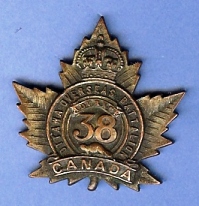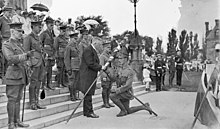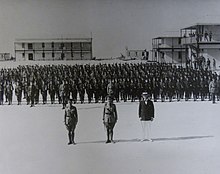The battalion took over the front line immediately east of Kemmel Hill (the southern end of the Ypres salient), where they remained until 23 September 1916. On that date, the 38th (and other units of the 4th Canadian Division) began its march south to join the remainder of the Canadian Corps in the Somme operations. A stop of one week was made near the village of Epileque for refitting and training. The battalion entrained at Saint-Omer, reaching Canaas on 9 October and bivouacking on the west slope of Tara Hill. Until 17 November, the 38th was occupied with work parties and periods in the front line.
On 17 November, the 38th took over a section of front line from the 11th Battalion of the Royal Dublin Fusiliers as part of the attack on Desire Trench and Grandcourt. The 38th went "over the top" for the first time on 18 November and all objectives were gained. The battalion had about 500 casualties, including 5 officers killed and 11 wounded. The battalion was relieved on 20 November, and what was left of it returned to Albert. After several days of reorganization, the march to the Vimy Ridge front began. The first three weeks of December were spent billeted in Bruay-la-Buissière where reinforcements were received, bringing the unit up to strength. The commander of the Canadian Corps, General Sit Julian Byng, inspected the 38th on 14 December. On Christmas night 1916 the 38th went into the line on Vimy Ridge at Souchez, relieving the 13th Royal Highlanders of Montreal. From then until the attack on 9 April, the battalion remained on the front. Many patrol encounters took place in No Man's Land; on 22 February the 38th raided the enemy's front line with a party of 125, inflicting heavy casualties.
Vimy Ridge
The 38th was relieved on 28 March and went into brigade support, returning to the line on the evening of 4 April ready for the "big show". When the attack began on 9 April, the task assigned the battalion was an objective well over the crest of the ridge; before evening, all objectives had been gained. Casualties were about 400 including Lieut. Col. Edwards, who was wounded. Major R. F. Parkinson assumed command of the battalion during Col. Edwards' three-month absence. The 38th was relieved on 13 April and was withdrawn to Hersin-Coupigny for reorganization. They returned to the line on 19 April, taking up a position east of Vimy Ridge near Lens. From 26 to 28 June, the 38th captured the towns of La Coulotte and Avion; meeting particularly stubborn resistance in Avion, the battalion's casualties during this three-day period were about 250.
They were relieved the night of 1 July, and withdrawn for three weeks of reorganization and training. King George V inspected the battalion on 11 July; August and September were spent in the line at Avion, and on 4 October it was learned that instead of using the Canadian Corps to attack the Mericout-Sallauminee Ridge, they were to be sent back to the Ypres front to take part in the Passchendaele operations. By mid-October, the 38th was en route to Belgium. On their way a week was spent near Staple; on the last day of their stay there the battalion was inspected by the Duke of Connaught, who had last seen the unit on Parliament Hill in Ottawa during summer 1915. From Staple the 38th moved to Ypres by motor lorries and went into the front line on 28 October, attaching to the 12th Brigade on the morning of 30 October. The 38th's objective was the outlying defences of the town of Passchendaele, and this had been gained by the end of the day. They were relieved the night of 3 November, after suffering about 400 casualties.
On 5 November 1917, the 38th moved From Ypres to Lozinghem for a month's rest and in December again went into the line at Avion. A busy winter was spent in this area, the battalion holding various sectors of the front from Oppy in the south to Loos in the north. The week beginning 17 March 1918, was marked by five separate German raids on the 38th Battalion front in one week. However, not one enemy soldier was able to penetrate the front line. The raiding parties numbered 50 to 200 men each time. When the German offensive began on 21 March 1918, the 38th were holding the line at Hill 70 and remained there for one week. On 28 March the battalion (along with the rest of the 4th Division) was rushed four miles south to relieve a British division which had been pushed back nearly two miles that day. They remained in this vicinity until the middle of May when the Canadian Corps was withdrawn into GHQ Reserve, where time was spent learning the new kind of warfare which the German offensive had made necessary. The 38th went back into the line just north of Arras on 19 July, remaining there until 2 August.
The 38th assembled for an attack in the Gentelles Woods (east of Amiens) on the night of 7 August 1918. The first objective was Cayus Wood. This was held until the evening of 9 August, when a further advance was made to Rosières. On the morning of 11 August, a strong line had been consolidated in the vicinity of Chilli. The Germans launched a counterattack, which was repulsed. The fighting continued until the night of 13 August when the 38th was relieved after playing a prominent role in the advance of 22,000 yards by the Canadian Corps, resulting in the capture of 167 guns, 1,000 machine guns and 10,000 prisoners. Casualties were very heavy.
On 30 August the battalion took part in action east of Feuchy, and on 1 September relieved the 8th Canadian Battalion at Ostrich Trench. The Germans counterattacked and were repulsed; that night, the battalion assembled for an attack the following day on the Canal du Nord. By the late afternoon of 2 September, the battalion reached the summit of Drury Hill. In the evening the Germans made a determined counterattack, but the 38th held on and by the mid-afternoon of 3 September the position was consolidated. Here the 38th broke the Drocourt-Quéant Line, capturing 325 prisoners, 4 trench mortars and 40 machine guns. The battalion's casualties were 3 officers and 57 other ranks killed, 7 officers and 176 other ranks wounded and 57 missing, for a total of 300.
The 38th entrained at Arras on 25 September, reaching their assembly position for the attack on Cambrai the following day. The battalion was tasked with capturing the railway near Bourlon, and the attack began on the morning of 27 September. The battalion crossed the Canal at Inchy; at the outset the it captured 25 machine guns and 150 prisoners, but by noon there was stiff opposition. Before the day was over the 38th had captured a battery of 5.9 guns, a battery of 77-mm guns, 28 machine guns, 2 anti-tank guns and 200 prisoners. The battalion continued on 28 September to capture positions in Marcoing Trench. At this time Lieut. Col. Gardner, who was in command of the battalion, was killed. The task of the 38th now was to cross the Douai-Cambrai Road; on 29 September the battalion moved forward and that day nearly all the officers and NCOs of the battalion were killed or wounded. The losses may be appreciated by the fact that on 26 September the 38th went into the line 570 strong and came out on 30 September with 96. The battalion was relieved on the morning of 30 September, after having gained its objective on the Douai-Cambrai Road.
After the Battalion had been reinforced and reorganized, it returned to action on 22 October. Plans for the attack on Valenciennes were completed by 31 October, and on the morning of 1 November the 38th went into action for the last time. Although other units also took part in the operation, platoons of the 38th were the first to enter the city. By 3 November Valenciennes was secure; on 5 November the battalion was relieved and billeted in Anzin, and it was here that the battalion received notice of the Armistice on 11 November.









